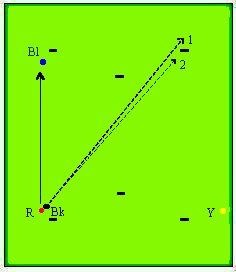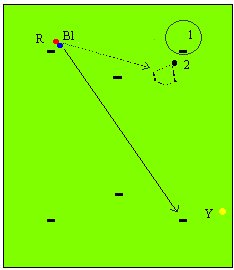
|
Back to |
| The Front Page |
| The Game |
|
Coaching the Fundamentals of the Stroke Part Nine: INSIDE THE RECTANGLE by John Riches Posted January 2, 1999 |
Australia's chief coach makes the case for updating the traditional wisdom on how and where to load the corner pioneer in your three-ball break. To get the benefit, you have to learn to make a reliable wide-angle split.

|
When I learned the game, I was taught to play a three-ball break by keeping the balls within the rectangle formed by the four corner hoops. This involved sending the croqueted ball about a yard short of the hoop when using a split or stop-shot to load your next hoop. In the diagram at the left, after making hoop 1, you would send the croqueted ball to position 2 behind hoop 3, instead of position 1, which is in front of the hoop. |
|
|
| Now we place less emphasis on this idea, and instead prefer to send the croqueted ball in front of the hoop to position 1. The reasons for this change are: (1) As illustrated in the diagram at the right, there is a much bigger (circular) area into which you can get your red striker's ball after making Hoop 2 and still be able to easily make hoop 3, compared with the smaller wedge-shaped area for position 2. (2) Loading the hoop within the rectangle often meant making the hoop from behind. (3) It is easier to get a useful forward rush when approaching the hoop from the front. |

|
|
|
Against this we must weight the fact that some players will find the wider angle split harder to control.
The moral is: Learn to play wide-angle splits confidently, then load your hoops in front rather than behind. One exception in a three-ball break is the 1-back hoop which should still be loaded with a ball placed inside the rectangle and behind the hoop; if you do not understand why, ask your coach to explain it.
[John Riches is the author of a number of coaching booklets, including "Croquet Technique", "Croquet Coaching: Error Correction", "Croquet: Lessons in Tactics", "Croquet: Next Break Strategy", " Croquet: The Mental Approach", and "Croquet: Finer Points".]